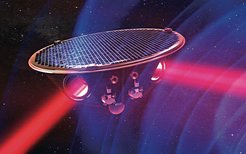Observing gravitational waves in space
Key experts for searching gravitational waves from space assemble in Potsdam on May 13-15

LISA, the Laser Interferometer Space Antenna, is an ESA-led mission set for launch in 2034. “The LISA project is developing rapidly, with a number of major milestones coming up within the next few years. One milestone is mission adoption, after which major industrial activity begins. Preparation for adoption requires both instrument and data analysis development to be brought to sufficient maturity. Researchers all over the world have therefore already started and must continue to develop the underlying theoretical tools and the required hardware and software from now”, Buonanno explains.
Researchers at the AEI Potsdam are experts in developing waveforms for the signals produced by various sources of gravitational waves, such as the coalescence of supermassive black holes, and the inspiral of a black hole or a neutron star into a supermassive black hole. “These waveforms are like fingerprints of the gravitational-wave sources. Our main goal is to precisely calculate the expected waveforms, in other words, model the expected fingerprints. The more accurately the waveform can be described, the more can be learned about a given gravitational-wave source from the data streams once LISA is flying,” says Buonanno.
LISA will allow the observation of gravitational waves from an exciting variety of new sources, such as
- The merger of two supermassive black holes at the center of colliding galaxies,
- A black hole or neutron star falling into a supermassive black hole, termed an “Extreme Mass-ratio Inspiral” or EMRI,
- 1000s of compact binaries (white dwarves, neutron stars or black holes) in our own galaxy,
- Binaries of stellar-origin black holes of the type being observed by the ground-based LIGO and Virgo detectors, but 1-100 years before merger,
- Decay of cusps in cosmic strings (if they exist),
- Intermediate Mass-Ratio Inspirals (IMRI) – 1000 solar mass black holes merging with supermassive black holes (hundreds of thousands to tens of millions of solar masses)
“With these new sources come new challenges in modeling their waveforms”, explains Maarten van de Meent, senior scientist at the AEI. “LISA will typically observe binary black hole systems for thousands of orbits, requiring waveform models that are accurate for much longer. Some of these systems will be one hundred times louder than anything observed so far by LIGO and Virgo, requiring models that are much more precise if the signals have to be removed from the data to the same level.” Harald Pfeiffer, group leader at the AEI, adds: “Finally, the ratio of the mass of the heavier component to that of the lighter component in an EMRI can be as large as a million. These systems are also expected to follow elliptical rather than circular inspiral trajectories. This is completely different from any system that has or will be observed with ground-based detectors and requires distinct modeling strategies.”
To address these challenges requires the development of theoretical, analytic and numerical methods. Within the LISA Consortium, the LISA Waveform Modeling Working Group is tasked with ensuring that these challenges are addressed and overcome before LISA's launch. It serves as an interface between the LISA Consortium preparing the mission on the one hand and the wider community of scientists working on gravitational modeling on the other.
The Max Planck Institute for Gravitational Physics in Potsdam has experts in all aspects of gravitational wave modeling and will play a leading role in the activity of the Waveform Working Group.
“We will learn most about the signals that LISA observes if we have accurate models for how those signals depend on the physical parameters of the system, and efficient ways to evaluate them. It will take many years to fully develop such models and the data analysis pipelines that will use them, that’s why this work must start in earnest now. The AEI will be at the forefront of this development and the exploitation of LISA data. The goal of this meeting is to bring together experts in source modeling, data analysis and instrumentation to understand the requirements that LISA will place on waveform models. These requirements will frame future waveform development over the next two decades", explains Jonathan Gair, group leader at the AEI in Potsdam.












